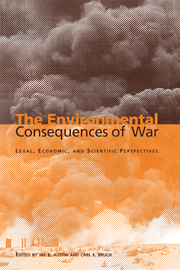Book contents
- Frontmatter
- Contents
- List of illustrations
- List of tables
- List of contributors
- Acknowledgements
- Foreword by Klaus Toepfer
- Introduction
- Part I General principles
- Part II The legal framework
- Part III Assessing the impacts – scientific methods and issues
- Introduction
- 11 Scientific assessment of the long-term environmental consequences of war
- 12 The Gulf War impact on the terrestrial environment of Kuwait: an overview
- 13 War-related damage to the marine environment in the ROPME Sea Area
- 14 War and biodiversity: an assessment of impacts
- Introduction
- 15 Tracking the four horsemen: the public health approach to the impact of war and war-induced environmental destruction in the twentieth century
- 16 Defoliants: the long-term health implications
- 17 The impact of military preparedness and militarism on health and the environment
- 18 War and infectious diseases: international law and the public health consequences of armed conflict
- Part IV Valuing the impacts – economic methods and issues
- Part V Prospects for the future
- Index
15 - Tracking the four horsemen: the public health approach to the impact of war and war-induced environmental destruction in the twentieth century
Published online by Cambridge University Press: 04 August 2010
- Frontmatter
- Contents
- List of illustrations
- List of tables
- List of contributors
- Acknowledgements
- Foreword by Klaus Toepfer
- Introduction
- Part I General principles
- Part II The legal framework
- Part III Assessing the impacts – scientific methods and issues
- Introduction
- 11 Scientific assessment of the long-term environmental consequences of war
- 12 The Gulf War impact on the terrestrial environment of Kuwait: an overview
- 13 War-related damage to the marine environment in the ROPME Sea Area
- 14 War and biodiversity: an assessment of impacts
- Introduction
- 15 Tracking the four horsemen: the public health approach to the impact of war and war-induced environmental destruction in the twentieth century
- 16 Defoliants: the long-term health implications
- 17 The impact of military preparedness and militarism on health and the environment
- 18 War and infectious diseases: international law and the public health consequences of armed conflict
- Part IV Valuing the impacts – economic methods and issues
- Part V Prospects for the future
- Index
Summary
Introduction
War marks the experience of every generation to have lived in the twentieth century. Journalists, historians, and demographers have reported its direct effects on human populations, in terms of immediate death and suffering. Reliable estimates suggest that, in the twentieth century, approximately 170 million people lost their lives in all forms of war and politically imposed violence. Other estimates, based on higher casualty figures for episodes of political violence that have not been fully evaluated, would indicate that as many as 270 million people might have died in this same time period from the direct effects of war, political oppression, state-induced famine, and acts of state terror.
Until recently, despite robust precedents set by individual practitioners in the nineteenth century, the public health profession has viewed this tide of death with a silence that is strange, considering that its mission is to attend to issues of morbidity and mortality in populations. The first section of this essay looks briefly at the reasons why the profession has taken considerable time to acknowledge the acute war-caused burden of morbidity and mortality as a major public health concern. This section also addresses the particularly relevant public health-related challenges that have been raised by conflicts since the end of the Cold War.
The second section addresses the main topic of this essay: the indirect effects of war on human populations, mediated through its destruction of biological habitat. These indirect effects have received even less systematic attention from the public health community, evidenced at least in part by the fact that this study required amassing and sifting data from many disciplines.
- Type
- Chapter
- Information
- The Environmental Consequences of WarLegal, Economic, and Scientific Perspectives, pp. 384 - 401Publisher: Cambridge University PressPrint publication year: 2000
- 1
- Cited by



